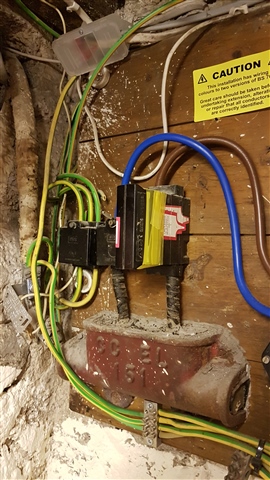There's no stopping me now.
The whole system feeds many single phase loads. There are no three phase machines on the holiday site so the loading may well not be balanced at all, just like a road supplied by a three phase supply with many individual houses using different amounts of electricity at any one time.
The switch fuse inside the open fuse box is not designed to be switched off as it will be enclosed when the door is in place. I imagine that it was used to fuse down an outgoing distribution circuit after the original hot wire fuse carrier became unserviceable. It contains a cartridge fuse.
Z.
I followed the main earth conductor down as far as what appears to be a woolly hat or tea cosy that obscures where it goes to.
I would decline to say what type of earthing arrangement there is without further investigation, I would hope it’s TNS.
I would hazard a guess at the UFO being a brown plaid lumberjack trapper hat.
Correct Watson. The black earthing conductor disappears into a black duct from which the underground supply emerges. P.N.B? I can't see how the earthing can be TNS as the supply to the intake room is by overheads for the majority of a very long run. I can't see a separate earth conductor. Perhaps I'm missing something.
It seems to be quite a small sized earth conductor for 400 Amp main fuses.
Z.
Want to try estimating the age of today's incomer?
It's right in the middle of Cardiff and the trolley buses used to go past the front door.

I gather Cardiff Corporation was generating and distributing electricity from about 1894 but I'd guess the early installations would have been intended only for lighting and similar so wouldn't have had as thick tails as those look to be - so I'd guess later when supplies were intended for a significant amount of power as well - say 1930s-ish.
- Andy.
Hmm the 'head' is new, but presumably originally also cast iron, and perhaps neutral or negative pole fused. I see that Cardiff had AC from before WW1 but also DC at 200, 400 and 500V as well. The PILC could be from almost any time from about 1900 to 1970, but the modern earth clamp is an addition. The use of tongue and groove as a back board, rather than ply or chip suggests pre-war.
my guess is 1920s perhaps, and original to the age of the house, rather than retrofit to victorian or earlier.
The yellow tape as a seal on the company fuse will be early 2000s, as are the 'new color' tails.
M.
We're about to take you to the IET registration website. Don't worry though, you'll be sent straight back to the community after completing the registration.
Continue to the IET registration site